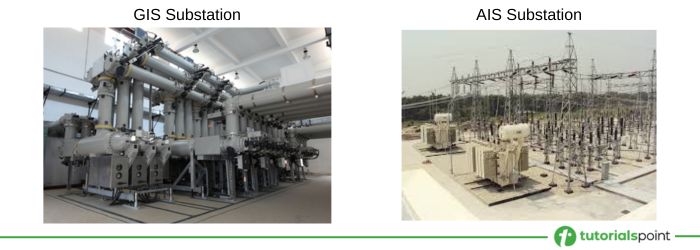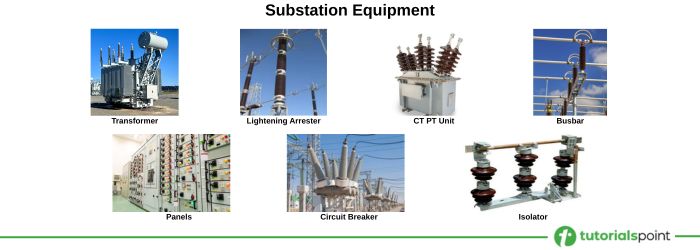
- Transformers
- Transformer Selection and Sizing
- Ratings of Circuit Breakers
- Ratings of Isolators
- Voltage Transformer
- Current Transformer
- Low Power Current Transformers
- Standard Ratings
- Design & Calculations
- Busbar Size Calculation
- Short Circuit Current Calculation
- Capacitor Bank Size Calculation
- Cable Size Calculation
- Voltage Drop Calculation
- Useful Resources
- Substation Design - Useful Resources
- Substation Design - Discussion
Substation Design - Introduction
In electrical power system, a substation is one of the most important parts, as it allows electric grid operators to generate, transmit, and distribute electricity efficiently and safely. Electrical substations work like a node in the electrical network where electricity is switched on or off and voltage is changed from high to low value or vice-versa. Apart from these two functions, substations also provide protection and monitoring of electricity flow in the grid. In simple words, we can say an electrical substation is an interconnection point between different parts of a power system.

In this introductory chapter, you will learn the fundamental concepts of electrical substations, their working, classification, functions, and much more.
What is an Electrical Substation?
An electrical substation, simply referred to as substation, is an arrangement of electrical equipment which are interconnected to control, protect, transform, and monitor the electric supply in the grid.
A typical electrical substation works by changing the voltage level, either from low to high or high to low. When voltage level is increased from a low value, it is called stepping up, and when it is reduced, then it is called stepping down. The working of a substation completely depends on its location within the power system.
What are the Functions of an Electrical Substation?
The following points highlight the working of a typical electrical substation −
- Firstly, electric power enters to the substation from a generating station or a high voltage transmission line.
- Secondly, a power transformer installed in the substation transforms the supply voltage either increase for further transmission or decrease for distribution purposes.
- Substations are generally equipped with switching and control devices like circuit breakers, isolators, etc. for switching or maintenance purposes.
- The protection and monitoring devices like relays and instrument transformers are installed for fault detection and isolation.
- Finally, transformed and regulated electric supply is transmitted or distributed for further utilization.
The operation and control of substation can be done manually on site or remotely from a central control room.
Classification of Substations
In electrical power system, substations can be classified in several types depending on voltage level, function, configuration, and insulation medium, as follows −
Types of Substations According to Voltage Level
Based on voltage class, substations can be classified into following three types −
- High voltage substations − These are also called HV substations or EHV (Extra High Voltage) substations. These substations are generally rated at or above 132 kV.
- Medium Voltage Substations − These substations are also termed as MV substations, and these are rated from 1100 volts up to 66 kV.
- Low Voltage Substations − These substations are referred to as LV substations and have a rating below 1100 volts.
Types of Substations According to Function
Depending on the functions performed, electrical substations are classified into the following types −
- Transmission Substation − These substations are used to interconnect two different transmission lines and change the voltage levels within a transmission range.
- Distribution Substation − A distribution substation is one having a step-down transformed installed and used to supply electricity to consumers.
- Converter Substation − This type of substation is generally used in HVDC (High Voltage Direct Current) systems for converting AC into DC and vice-versa.
- Switching Substation − These substations have only switchgears and have no transformer for changing voltage level.
Types of Substations According to Configuration
Electrical substations are also classified as per configuration as follows −

- Indoor Substations − These substations are installed within a building. Their all equipment are housed within the same building. This type of substation is generally seen in urban and industrial areas.
- Outdoor Substations − In these substations, all power equipment are installed outdoor in open. This configuration of substation is very popular in rural and spacious areas.
Types of Substations According to Insulation Medium
Substations are classified into following two types based on insulation medium used −

- Air-Insulated Substation (AIS) − In AIS substation, equipment like transformer, switchgear, etc. are insulated by air medium. This substation has larger size, but are cost effective.
- Gas-Insulated Substation (GIS) − In GIS substations, equipment are insulated from one another by SF6 These substations are compact and reliable, but they are expensive to setup.
Main Components of Substation
An electrical substation consists of several important components, where each performs a specific function. Some of the critical components of a typical substation are listed below −

- Transformer − It can be a power transformer or distribution transformer depending on the function of the substation. Transformer is the heart of substation and it performs voltage step-up or step-down function.
- Circuit Breaker − CB is another critical component in a substation. It is used to interrupt the flow of electric current in the system, either during fault or normal switching.
- Isolators − It is also termed as disconnect switch which is operated manually. It’s main function is to isolate a part of system for maintenance purposes. It provides visible disconnect of the network and ensures safety. It is a no-load device, hence it must be operated during uncharged condition of the system.
- Busbar − It is nothing but a bar conductor of copper or aluminum used to connect multiple incoming or outgoing feeders to the substation.
- Current Transformer − CT is used to reduce high currents of transmission line for measurement and protection purposes.
- Potential Transformer − PT is used to reduce the high voltage of transmission line to a value suitable for metering and protection.
- Lightening Arrester − LA, also known as surge arrester, is a protection device that safeguard equipment from lighting and switching surges.
- Control Panels − These are metallic cabinets used to house relays, meters, and control circuits in a substation.
- Earthing System − It is another crucial part of a substation which is used to discharge fault currents to the earth and protect operating personals.
Functions of Substation
An electrical substation performs several different functions within a power system. Some of the key functions of a typical substation are listed here −
- Voltage Transformation − This is the most fundamental function of an electrical substation. Substations transforms voltage by employing a transformer. It can either increase or decrease the voltage level depending upon the requirement.
- Power Flow Control − Electrical substation performs control and regulation of electric power in transmission and distribution lines and maintains the power system stability.
- System Protection − Electrical substation also detects and isolates faults in the electrical system and prevents major outages.
- Metering and Monitoring − It is another key function of an electrical substation. Electrical substations use different types of measuring devices like ammeter, voltmeter, power factor meter, watt meter, and more. This metering and monitoring be essential for performance analysis and billing purposes.
- Load Management − Substations also balance the load across different areas and effectively manage the load to avoid system overloading and unwanted trips.
- Interconnection Point − Substation also serves as a point for interconnection and allows for interconnecting multiple transmission lines from different generation stations or substations.
Why are Substations Required?
In electrical power system, substations play an important role because of the following major reasons −
- They allow for loss minimization and efficient power delivery.
- Substation increases safety of the system by enabling isolation of faulty parts.
- Substation ensures continuous power flow and improves reliability.
- It also provides scope for integration of new generation plants and further expansion.
- Substations also provide electricity at proper voltage level to different consumers.
- Substations allow to integrate electrical networks with SCADA systems automated and remote monitoring.
Conclusion
To conclude, a substation enables seamless control, transmission, and distribution of electric supply to consumers. Substations allow grid operators to monitor and control voltage levels, isolate faults, and minimize the power losses.